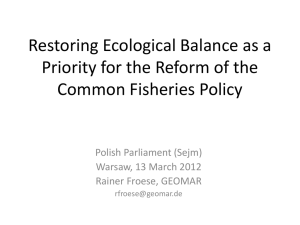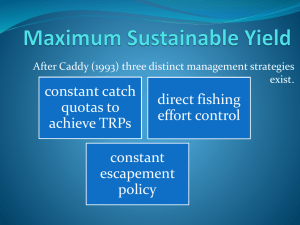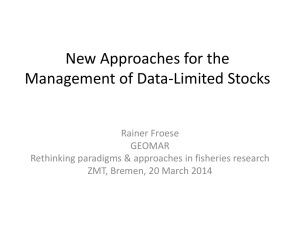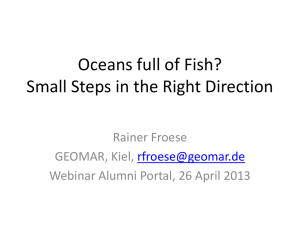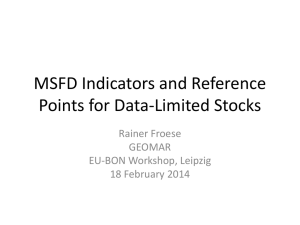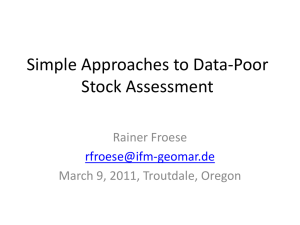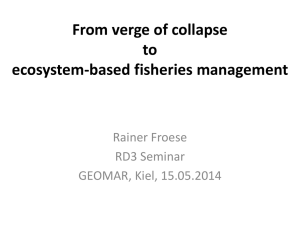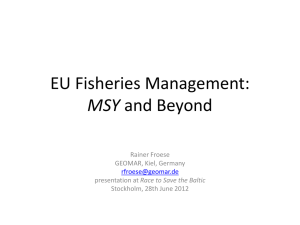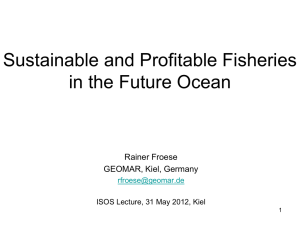PPT - FishBase
advertisement
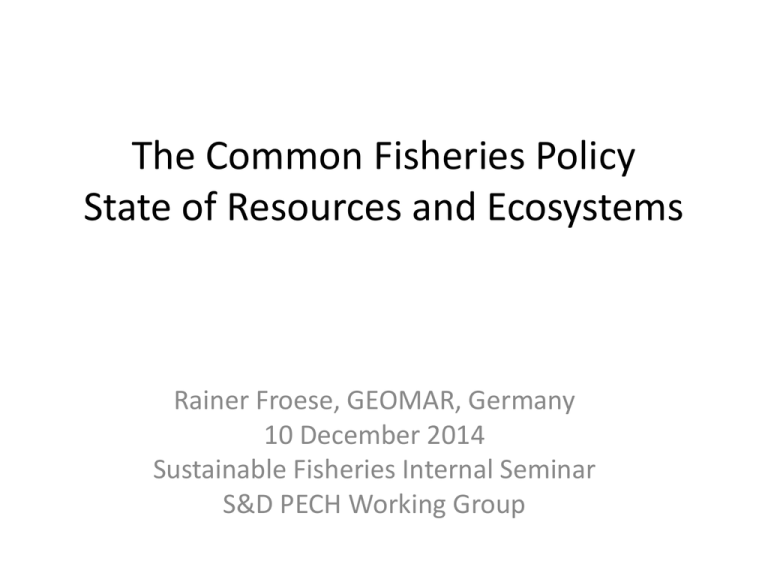
The Common Fisheries Policy State of Resources and Ecosystems Rainer Froese, GEOMAR, Germany 10 December 2014 Sustainable Fisheries Internal Seminar S&D PECH Working Group Overview • • • • • • Revisiting MSY, Fmsy, Bpa and Bmsy State of Resources State of the Ecosystems Rebuilding stocks above MSY-Level Minimizing the Impact of Profitable Fishing Summary Revisiting MSY, F, Fmsy, Bpa and Bmsy • MSY is the maximum catch that a stock can deliver long-term • Bmsy is the biomass that can produce MSY • Bpa is the biomass below which recruitment may be compromised • F is the fraction of the fish (present during the year) that are caught • Fmsy is the F that leads to MSY and Bmsy, albeit in infinite time Management Framework 1200 proxy Bpa SSBlim Bmsy constant recruitment 1000 Recruits 800 600 Outside safe biological limits 400 200 0 0 100 200 300 400 500 600 Spawning stock size Froese et al. 2014 State of the Resource State of the Resource: Stock Size • The offical reference points for safe biological limits (Bpa) are often based on the lowest stock size ever observed (Bloss) • With Bpa properly estimated, 52% of the stocks were outside of safe biological limits, and 12% were severely depleted. (Froese et al. 2014) State of the Resource: Stock Size • • • • CFP requires rebuilding of stocks above Bmsy There are no official reference points for Bmsy But 2*Bpa can be used as a proxy for Bmsy In 2013, 88% of the stocks were below the proxy for Bmsy Froese et al. 2014) State of the Resources: Fishing Mortality F • Fisheries science holds that sustainable fishing mortality Fmsy has to be less than natural mortality M • However, official estimates of Fmsy exceeded natural mortality M in 76% of the stocks • Fishing mortality in 2013 exceeded natural mortality in 73% of the stocks, including those that were severely depleted (Froese et al. 2014) State of the Resource: Maturity • Fisheries science and common sense hold that fish shall reproduce before being caught • In 74% of the stocks, the age at first capture was below the age at first maturity (Froese et al. 2014) State of the Ecosystems • What is the minimum stock size that still allows species to fulfil their ecosystem role as prey or predators? • Fisheries science holds that 2/3 of unexploited population size may be a lower limit for regular fish (with F ~ 0.8 Fmsy) and ¾ may be a lower limit for forage fish (with F ~ 0.5 Fmsy) (Froese et al. in prep) Food Web of the Western Baltic Sea 5 Sprat is a central food organisms and „natural“ predators must compete for it with the fishery. Harbour Porpoise Fishery Seals 4 Adult Cod (Sea-) Birds Juvenile Cod Adult Herring Other Demersal Fish 3 Juvenile Herring Other Pelagic Fish Sprat Pelagic Macrofauna Flatfish Zooplankton 2 Trophic Level Benthic Meiofauna Bacteria/Microorganisms Benthic Macrofauna Benthic Producers Phytoplankton Detritus / DOM Opitz & Garilao unpublished State of the Ecosystems • What is the age and size structure that allows a population to reproduce and fulfil its ecosystem role as prey or predator? • The natural length at first maturity is about 1/3 to ½ of maximum length • The natural average length of parents is about 2/3 of maximum length • Starting fishing at about ½ of maximum length allows all fish to reproduce and leads to natural average length; it also maximizes catch and biomass for a given F (Froese et al. in prep.) Long-term Catch as a Function of F/M and Length at First Capture Froese et al. in prep. Biomass as a Function of F/M and Length at first Capture Froese et al. in prep. Maximizing Profits of Fishers • Profit of fishers is the difference between the value of the catch and the cost of fishing • Cost of fishing is a function of the abundance of fish • Highest profits are obtained at about 1.2 Bmsy • 1.2 Bmsy is therefore the target biomass level in Australia Follow the Money… Profit Value of catch Profit Profit Cost Cost Cost Froese et al. in prep. Summary • In 2013, about ¾ of the stocks were too small, were fished too hard, and were caught before reaching maturity • For stocks to rebuild above levels that can produce MSY, F has to be smaller than Fmsy • For minimizing impact of fishing and maximizing profits, F should not exceed 0.8 Fmsy and length at first capture should be about half of maximum length • For forage fish (herring, sprat, anchovy, …) to fulfil their crucial ecosystem duties, F <= 0.5 Fmsy Thank You
